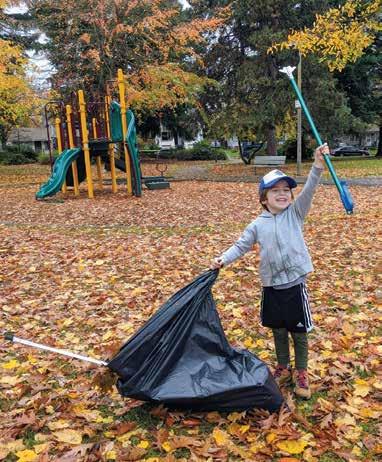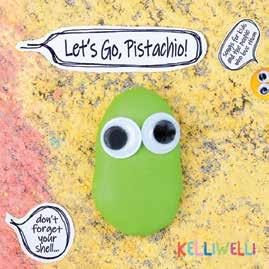
17 minute read
Editor’s Note
Icheered when Multnomah County voters passed the Preschool for All measure in November 2020, because I am a living testament to how life-changing free child care can be.
When I was offered the job as managing editor of PDX Parent in 2014, I had not been working outside the home since my then-2-year-old daughter, Adela, was born. I wanted the job, but knew almost my entire paycheck would be swallowed by child care costs. (Case in point: the Economic Policy Institute states that child care for a 4-year-old in Oregon costs almost as much as state college tuition.) But I was extremely privileged to have in-laws willing to take Adela two days a week for free, so I was able to say yes to the part-time job with flexible hours. And not only did my in-laws, Betsy and Craig, take care of Adela (and eventually her little brother, Cruz), they took her on wonderful adventures to library storytimes, messy art at Spark Arts, the Oregon Zoo, Multnomah Falls, the Wooden Shoe Tulip Festival, OMSI, you name it. They got to really know their granddaughter, she got showered with love and attention — if sometimes a little too much sugar — and I got to do a job that is creative and fulfilling, and put my years of magazine editing experience to good use. I earned pay raises and eventually a promotion to editor. If I had never taken the job because it didn’t make financial sense at the time, I never would have reached the place where I could
CRAIG PARKER solidly contribute to my family’s household income. A mother shouldn’t have to rely on being lucky enough to have willing and reliable grandparents to afford to work. Yes, Multnomah County’s universal preschool will prepare kids for kindergarten and beyond, and will pay preschool teachers a wage that more accurately reflects the importance of their job. But the benefit that is not discussed as much is that parents (mostly mothers) will be able to work outside the home if they choose, because they will have free child care for their 3- to 4-year-old children. And that years later, they will be much better off financially.

DENISE CASTAÑON
Knowing the impact free preschool will have on families, I was eager to learn how universal preschool in Multnomah County will work. And I figured other parents would want to know, too. Thanks to writer Shasta Kearns Moore for diving into Multnomah County’s trailblazing measure and spelling it out for us. Spoiler alert: Universal preschool is not happening in the immediate future, but see the timeline on page 11 for more details.
On our cover: Suzanne Puttman of Click by Suzanne took our adorable cover photo during one of her preschool class sessions at Multnomah Athletic Club (MAC). “Shooting preschool photos is really fun because you need to work fast, and have fun with it,” says Puttman, a mom of three. “As a photographer you need to win the kids over quickly, so they will open up and show you their little personalities.” We think she’s got it down! Find more of her work at clickbysuzanne.com and facebook.com/clickbysuzanne.
for the long days and short years
PDX Parent P.O. Box 13660 Portland, OR 97213-0660 Phone: 503-460-2774
Publisher Rose Caudillo, 503-460-2774 publisher@pdxparent.com
Editor Denise Castañon, 503-922-0893 denise.castanon@pdxparent.com
Art Director Susan Bard
Web Director Michelle Carew, 503-914-6151 michelle.carew@pdxparent.com
Eastside Account Executive Lauren Wylie, 503-331-8184 lauren.wylie@pdxparent.com
Westside Account Executive Jill Weisensee, 503-309-8272 jill.weisensee@pdxparent.com
Newsletter and Calendar Editor Melissa Light melissa.light@pdxparent.com
Finance Manager Christie Kline, 503-810-9817 christie.kline@pdxparent.com
President Jill Weisensee jill.weisensee@pdxparent.com
For distribution issues, e-mail us at distribution@pdxparent.com
For calendar submissions, e-mail us at calendar@pdxparent.com
PDX Parent is published monthly (except July) by Northwest Parent, LLC., and is copyright 2021 Northwest Parent, LLC. All rights reserved. Reproduction in whole or in part without written permission is prohibited. PDX Parent is distributed free of charge throughout the Portland, OR / Vancouver, WA metropolitan area. PDX Parent reserves the right to refuse advertising for any reason. Distribution of this publication does not constitute an endorsement of the products or services advertised herein. PDX Parent does not discriminate on the basis of race, color, national origin, religion, disability, gender, gender expression, sex or sexual orientation. Although every effort is taken to ensure the accuracy of published material, Northwest Parent, LLC., and its agents and employees cannot be held responsible for the use or misuse of any information contained herein. The contents of PDX Parent and its website are for informational purposes only and are not intended to be a substitute for professional advice or treatment.
Good Deeds: keep it clean
Dismayed by the seeing litter in Portland, Frank Moscow decided to stop complaining about it and make a positive change. Moscow started Adopt One Block, an organization that asks people to sign up to “adopt” a block in Portland with the goal of cleaning up litter. “People and families get to clean up the block they care about the most (likely their own or one close by), when and how they want, with cleanup supplies we deliver for free,” says Moscow. “My son, Jack, 7, and I adopted the block that is George Park in St. Johns,” says Brett Duesing. “I like the concept of Adopt One Block. You can chip in your time on your own schedule, you don’t have to go to meetings, and you focus the work on wherever you find the problem. Pretty powerful if you get hundreds of people doing it.” And, in fact, hundreds of people in Portland have signed up to be “block ambassadors.” Portland is the test city for Adopt One Block, and more than 500 blocks have been adopted. Moscow plans to expand to more cities soon. To sign up your family, visit adoptoneblock.org. — Denise Castañon

takeout spots for pancakes
TOP 5 ... One of the lessons of 2020: Celebrate the little things. Feb. 16 is National Pancake Day, and that’s reason enough to seek out flapjacks to go at a restaurant near you. ➊ Black Bear Diner’s “cub” breakfasts are on the menu all day long. Your kids will probably angle for the chocolate-chip pancakes. Pro tip: Their online ordering system is a breeze! Locations in East Portland, Gresham, Beaverton and Vancouver. Delivery, pickup or curbside pickup. Blackbeardiner. com. ➋ At Multnomah Village’s Marco’s Cafe, you can order a kid’s pancake — and maybe an avocado-bacon benedict for you. Covered, heated outdoor dining; Grubhub and DoorDash delivery; or pickup. Marcoscafe.com. ➌ City State Diner & Bakery on Northeast 28th Avenue lets you top pancakes with chocolate chips, granola, toasted coconut or blueberries. Breakfast served all day. Covered outdoor seating, pickup or delivery. Citystatediner.com. ➍ While it is normally closed on Tuesday, which National Pancake Day lands on this year, the iconic Original Pancake House in Southwest had to make our list. The abundant pancake menu includes sourdough, buckwheat, pecan and coconut varieties, among others. The classic silver dollar cakes or puffy Dutch baby are sure bets. Pickup. Originalpancakehouse. com. ➎ Cameo Cafe’s “acre” buttermilk pancakes will fill a whole plate. They also offer special savory Korean pancakes stuffed with rice and veggies. Locations on Northeast Sandy Boulevard and in Vancouver. Outdoor dining and pickup. Cameocafe.com. — D.C.

Bookshelf: Cool to Be Kind
Sure, February is all about romantic love, but we also want to celebrate the love for others that shines through simple acts of kindness. Kim Tano, the children’s book buyer at Powell’s City of Books, helped us out by selecting her favorite kids’ books on kindness for toddlers to tweens. (And, good news: The Burnside, Hawthorne and Cedar Hills Powell’s locations are now open for in-person browsing. You can always order online at powells.com.)
PENGUINN RANDIM HOUSE Kindness Makes Us Strong by Sophie Beer From the author of Love Makes a Family, Kindness Makes Us Strong is a perfect tool for teaching the language of kindness to young readers. From simple acts of kindness to the bigger concepts of generosity and how it affects our inner strength, this board book is a great addition to any home with kids 2 and up. $11.99.
RANDOM HOUSE FOR YOUNG READERS
HARPER COLLINS Penguin Problems by Jory John and Lane Smith Poor Penguin! His beak is cold. He doesn’t like snow. He’s not buoyant enough. He feels silly when he waddles and he has to deal with all the squawking! Can Walrus persuade him to view life differently and appreciate all that he has? A charming picture book that teaches kindness and compassion. Ideal for kids ages 3 and up. $8.99.
Extra Yarn by Mac Barnett and Jon Klassen Annabelle discovers a magical box full of yarn of every color. After she knits herself and her dog a cozy sweater, there is extra yarn. She continues to knit sweaters for her community, and people come from all over the world to meet Annabelle. Is the yarn box magical? Or is Annabelle? This Caldecott Award winner is great for ages 4 and up. $17.99.
Front Desk by Kelly Yang Ten-year-old Mia loves running the front desk at the hotel her parents manage while they clean the rooms. However, if the mean motel owner finds out about her parents letting immigrants stay in the empty rooms, everyone will be in big trouble. But Mia’s and her parents’ kindness makes it hard to say no to people in need. Perfect for ages 9 and up! $7.99.
Ask the Middle School Counselor
Q: He hasn’t come out, but I think my sixth-grade son is gay. I am fully supportive, but I think he feels ashamed. How can I let him know I will always support and love him, and that I just want him to be comfortable with himself?
A: This question makes me happy to read. You are already on the right path by even asking this. I’m going to advise you to be patient with your son. It may be tempting to bring it up directly in an attempt to get it out of the way or to make him feel comfortable, but letting him go through his own process is important — sacred, really — and all kids are different. Let him be the driver here.
As a school counselor, I’ve had students come out to me as the first person they’ve told they were gay (or bi or trans). You know what I did? I acted like it was the most important news I’d ever heard. I thanked them for trusting me even when — especially when — I had thought for ages that they were LGBTQ. I told them I was proud of them and asked how I could support them.
I would suggest that you be sure to mention LGBTQ+ folks in a positive way, but I’m going to guess you already do that. Reassure him regularly that you love him no matter what, check in with him about his life without too much problem-solving or judgment, make sure he’s exposed to all kinds of diversity, and if/when he comes out, don’t say, “I knew you were.” Oh, and check out online resources like PFLAG, and talk to other parents or LGBTQ friends.
Sahjo Brown is a 20-year veteran of school counseling, mostly at the middle-school level. She has one kid, a dog, a cat, five chickens and some fish. (And secretly wishes she could add in some rabbits.) Her favorite part of working with middle schoolers is their desire to connect and build relationships; plus, their pop culture references keep her on her toes.
Gear Guide:
Tech Guidelines for kids and tweens
We reached out to Anne Bryan, CEO of Circle, a company that helps parents manage and monitor their children’s screen time, for suggestions of age-appropriate tech use for kids and tweens. Bryan is mother to four boys ages 17 and older, and also a former chair and current member of the Beaverton School Board.
Here’s what she suggests. ANNE BRYAN
Third to fifth graders
For kids who are 8 to 10 years old, it is important to establish screen time and device boundaries from the start. Sure, many families had to modify screen time rules in 2020. In fact, half of kids (48 percent) surveyed at the start of the pandemic were spending more than six hours per day online (a 500 percent hike since before the crisis). It goes without saying that kids will be online more now than ever before with school and most social activity happening online. But a consistent schedule for when your child can use their device for school, for social and entertainment needs — and when they should be off it altogether — will help set expectations for responsible use. Set up device controls. Set time limits for screen time so your kids can stay on track throughout the year, while also taking interest in nondigital activities, like reading, playing an instrument or getting active outdoors for a more well-rounded day. Build in some downtime. Taking digital breaks throughout the day is important for kids’ attention span and productivity. Cyberbullying can start around this age. Look for signs they’re having a negative experience on their device, such as being emotionally upset during or after use, withdrawing from friends and family, or not doing well in school, and then have a conversation with them about their experience.
Product suggestion: KidsConnect KC2 4G Kids GPS Tracker
Tweens
The tween years are when the pressure really starts for parents considering buying their kid a phone. With so many of us living in relative isolation, tech tools have taken on a whole new role in kids’ lives as they try to stay connected with their friends in healthy ways. It’s natural for parents to be nervous about their young teens owning a smartphone. But there are benefits for both you and your kids when you decide the time is right, like quick communication and learning responsibility. In any event, whether it’s today or three years from now, it’s likely your kids will own a smartphone eventually. If you’ve had productive conversations with them and feel confident they’re ready to make smart choices with that responsibility, they can start to develop independence and good habits around their own screen time that will benefit them in the future. There’s no magical age when kids are ready to have a smartphone. But if you’ve been actively addressing the topic of screen time and the dangers of smartphones with your son or daughter and they are receptive to your input, it may be time. The real matter at hand is trust. Is there mutual trust between you and your tween? If you trust them, they can probably handle the responsibility of a smartphone. And if they trust you, they can come to you with any issues that may pop up. Of course, no matter how trustworthy or responsible your kid is, things can show up that they aren’t expecting. That’s why parental controls matter. Because of sheer exposure and ease of access to screens, tweens are very susceptible to screen-time addiction, dependency and cyberbullying. Keep a watchful eye on their usage and utilize tools to limit access to sites and platforms where you see overuse happening. Tweens are going through important, and sometimes uncomfortable, social development and screens can amplify that experience. They rely on the adults in their life to help them set boundaries.
Product suggestions: Wacom Intuos, a drawing tablet with a super-light pressure sensitive pen, wacom.com. Jackbox Games, streaming games that can be played over Zoom, jackboxgames.com.
WACOM

We Recommend: Baby Care Book From a Pro The first few days home with a new baby are packed with questions. How do I get a good latch? Is he eating enough? Is this normal? The New Baby Blueprint, by one of our favorite local pediatricians, AMERICAN ACADEMY OF PEDIATRICS Whitney Casares, M.D., M.P.H., F.A.A.P., covers not only baby care, but self-care for new moms. The mother of two young children, Casares strenuously argues against the image of the “perfect mom” and gives straightforward advice on keeping babies safe in the first few weeks home. Find it at: shop.aap.org/ the-new-baby-blueprint-paperback. — D.C.
Playlist: Going Nuts

Portland kindie artist Kelli Welli just released a new album of silly and bright tunes for kids. Parents and caregivers of toddlers will identify with the twangy, rockabilly title track, Let’s Go, Pistachio! Play Tinkle Tinkle Toot for toilet-averse toddlers; the potty humor may make the arduous task of potty training somewhat easier ... or at least funnier. I’m Proud of You is the sweet anthem we all need to hear. (Seriously, play it for yourself while pandemic parenting and try not to sob.) Another standout: The oh-so-Portland song Kickin’ It With My Chicken. — D.C.
Ask Dr. Doug
Q: My newborn has a red rash on his cheeks and chest. I hear so much advice about what to put on them. What do I do about baby rashes?
A: Babies have lots of normal rashes after they are born, and almost none of them require any treatment.
One of the most common is called erythema toxicum, which is a rash of little white bumps on a flatter red base, pretty much anywhere on the body. It usually pops up when a baby is two or three days old. Even though it has a name that sounds like a Harry Potter spell, don’t worry — it’s harmless and goes away on its own within a few weeks.
Some babies have peely skin on their bellies and chest in the first week. This is normal, and flakes off on its own. Sometimes the peeling is worse on the wrists and ankles, and I usually recommend moisturizing those areas once or twice a day. If parents have a history ? Got a question for Dr. Doug? Send it to AsktheDr@pdxparent.com. of dry skin or eczema, I would moisturize your baby twice a day even if their skin feels fine. There is some research this helps prevent eczema and may even prevent food allergies, since some develop by being sensitized through the skin.
Look for plain moisturizers without fragrances or essential oils: Aquaphor, Vanicream and Aveeno Baby are my favorites.
Babies of color may get a rash called transient neonatal pustular melanosis. While that’s a mouthful, it too goes away on its own and doesn’t need treatment. This rash looks like tiny, pus-filled bumps that pop and turn into darker flat areas.
Many babies will get seborrheic dermatitis, or cradle cap. This is a greasy, scaly rash in the scalp that often comes down onto the cheeks and eyebrow areas. Sometimes it needs topical 1% hydrocortisone and moisturizer if it gets inflamed and itchy. But in general, gentle brushing after shampooing works best. Olive oil can feed skin yeasts and make it worse, so I usually recommend mineral or coconut oil if we have to soften up the flakes.
One rash that is never normal in a newborn is herpes. Anything that looks like a cluster of small, clear, fluid-filled blisters, or anything that looks like a cold sore, needs to be evaluated right away. Unfortunately, babies can get sick and even die from the herpes virus.
Around four to six weeks, babies go through a mini-puberty. This means they start vaping and doing TikTok dances. No, I’m kidding. But they do often develop baby acne. This looks like reddish bumps, some that have a bit of pus, on their cheeks and often down onto their upper chest. No need for face washes — this one goes away on its own.
In general, baby skin needs a gentle moisturizer when dry and lots of kisses, and that’s about it!
Dr. Doug Lincoln practices general pediatrics at Metropolitan Pediatrics in Happy Valley. He is board-certified in both pediatrics and preventive medicine, with special interests in helping parents meet their breastfeeding goals, caring for neurodiverse children with behavioral health needs, and advocating for children via teaching and policy. As a dad of two boys, he understands the joy and hard work that comes with parenting. Find out more about Dr. Doug and Metropolitan Pediatrics at metropediatrics.com.
DR. DOUG

